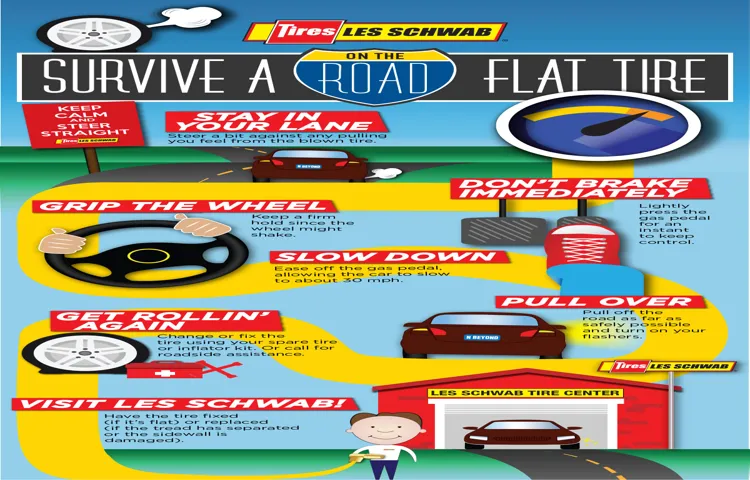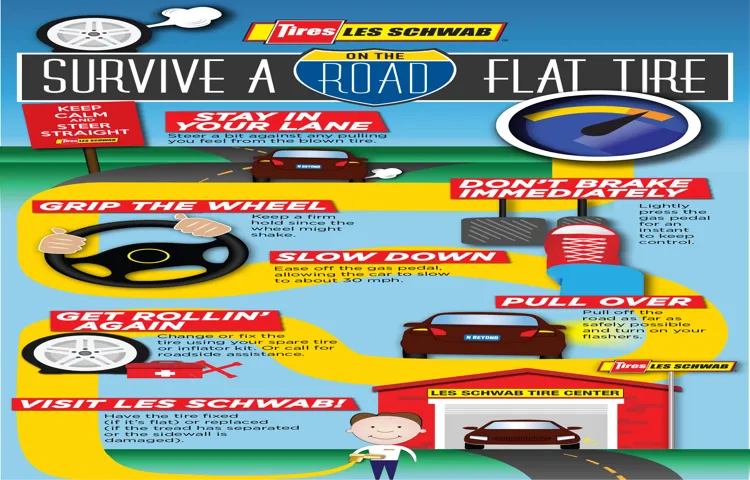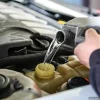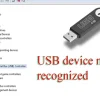Have you ever been driving down the road, enjoying your day, and suddenly feel a wobble in your car? You glance down, and your worst fears are confirmed – you have a flat tire. This can be a stressful and dangerous situation, but knowing how to deal with a flat tire while driving can make all the difference. In this blog post, we’ll discuss the steps you can take to safely navigate a flat tire while on the road.
From slowing down to finding a safe spot to pull over, we’ll help you stay calm and in control when faced with this unexpected challenge. So buckle up, and let’s get started!
Table of Contents
Stay Calm and Pull Over Safely
Getting a flat tire while driving can be overwhelming, but it’s important to stay calm and pull over safely. First, turn on your hazard lights to let other drivers know you’re experiencing an issue. Try to find a safe spot to stop your car, ideally away from traffic and on level ground.
Once you’ve stopped, engage your parking brake and use a tire block or wedge (if available) to keep your car from moving. If you have a spare tire, consider using it to replace the flat tire temporarily while you seek professional help. If you don’t have a spare tire or feel uneasy about changing the tire, contact roadside assistance or a local tow truck.
Remember to never drive on a flat tire and always prioritize your safety on the road.
Find a Safe Spot to Stop
When you are driving and need to pull over, it is essential to find a safe spot to do so. The first thing to do is stay calm – a panic will only make the situation worse. If possible, try to pull over to the side of the road, out of the way of any traffic.
Look for a flat and stable area and signal your intention to pull over by turning on your hazard lights. If you are on a busy street or highway, ramp up your awareness. Look out for a rest area, a parking lot, or a break in the median where you can safely cross over to the other side.
Remember to check your mirrors before changing lanes or pulling over. If there are no safe spots to pull over, consider driving a bit further until you find a suitable area. Finding a safe spot to stop is crucial for yours and others’ safety, so take your time and do it right.

Turn on Your Hazard Lights
When you’re driving and something goes wrong, remaining calm is crucial. One way to alert other drivers that there’s an issue with your vehicle is by turning on your hazard lights. Hazard lights are crucial in situations where your vehicle is suddenly experiencing difficulty or is in danger.
Turning on your hazard lights will alert other drivers that something is wrong and to take precautions when passing. However, it’s essential to ensure that you pull over safely. Pulling over and stopping your car is the best way to figure out what’s wrong and address it before continuing your journey.
The hazards enable you to give warnings to other drivers, which is important if your vehicle is not moving at regular road speeds. Remember to avoid turning on your hazard lights in non-emergency situations to avoid causing confusion to other drivers. By being vigilant and careful, you can prevent further damage to your car or cause harm to yourself and others on the road.
Assess the Damage to Your Tire
Getting a flat tire while driving can be a stressful experience, but it’s important to assess the damage to your tire before taking any action. If you notice a flap of rubber that’s hanging loose or bulging out of the sidewall, then you have a blowout and it’s not safe to keep driving. However, if there’s just a small puncture on the surface, then you may be able to use a tire repair kit or spare tire to get back on the road.
It’s also important to check the air pressure in the rest of your tires to ensure they’re properly inflated before continuing your journey. Remember, safety should always be your top priority, so don’t hesitate to call for roadside assistance or a tow truck if you’re uncertain about the condition of your tire.
Check for Any Obvious Punctures or Damage
Assessing the damage to your tire is crucial for maintaining its longevity and ensuring your safety on the road. One of the first things to check for when assessing your tire is any obvious punctures or damage. This can be done by carefully inspecting the surface of the tire for any signs of wear and tear, such as cuts, gashes, or cracks.
These can be caused by a variety of factors, such as sharp objects on the road or driving over rough terrain. It’s important to note that even small punctures can cause significant damage to your tire if left untreated. Therefore, it’s essential to address any issues as soon as they are discovered.
By taking the time to assess the damage to your tire, you’ll be able to catch any problems early on and prevent further issues from developing.
Check the Tire Pressure
When it comes to taking care of your vehicle, regularly checking your tire pressure can save you from unexpected blowouts and prolong the life of your tires. In addition to checking the air pressure, it’s important to assess for any damage to the tire itself. Start by looking at the tread depth for any signs of wear or bald spots.
If you notice any cuts or punctures on the sidewall or in the tread, this could be a sign of a leak or potential blowout hazard. It’s also important to check for any bulges or bubbles on the tire, as this could be a sign of internal damage. If you notice any of these signs, it’s best to take your vehicle to a professional for a closer inspection and possible tire replacement.
By staying on top of your tire maintenance, you can ensure a safer and smoother ride every time you hit the road.
Replace the Flat Tire
Getting a flat tire while driving can be a stressful experience, but knowing what to do in that situation can make all the difference. The first step is to safely pull over to the side of the road and turn on your hazard lights. Then, check your vehicle’s owner manual to find the location of the spare tire, jack, and lug wrench.
Once you have all the tools you need, remove the hubcap and then loosen the lug nuts. Next, place the jack under the vehicle and begin to jack it up until the tire is off the ground. Remove the lug nuts and the flat tire, and then place the spare tire on the car’s bolts.
Tighten the lug nuts by hand, and then lower the vehicle to the ground. Finally, use the lug wrench to tighten the lug nuts as much as possible. Remember to get your flat tire repaired or replaced as soon as possible.
By following these steps, you’ll be back on the road in no time.
Locate Your Spare Tire and Tire Changing Tools
Replacing a flat tire can be daunting, but it’s essential to know how to do it in case of emergencies. The first step is to locate your spare tire and tire changing tools. Usually, the spare tire sits in the trunk or under the vehicle’s floor.
Additionally, the tools necessary to change the flat tire are usually located near the spare tire. Once you have located both of them, it’s time to replace the flat tire. Start by loosening the lug nuts with a wrench in a counterclockwise direction.
Once they are loose, use a car jack to lift the vehicle off the ground and remove the lug nuts and the flat tire. Then, place the spare tire onto the wheel hub and hand tighten the lug nuts. Lower the car and use the wrench to tighten the lug nuts in a clockwise direction.
It’s essential to tighten them in a star pattern to ensure an even distribution of force. Once you’re finished, double-check the tightness and store the flat tire back in its original location. By following these steps, you’ll be back on the road in no time.
Loosen Lug Nuts and Jack Up the Car
When it comes to replacing a flat tire, there are a few essential steps you need to follow. Firstly, start by loosening the lug nuts on the flat tire using a lug wrench. Be sure to turn the wrench counterclockwise, as this will loosen the nuts.
Once you have loosened the lug nuts, it’s time to jack up the car. Position the jack under the designated jacking point and pump the jack handle until the flat tire is around six inches off the ground. Before removing the lug nuts completely, it’s important to double-check that the jack is securely holding the car in place.
Once you have confirmed this, you can safely remove the lug nuts and take the flat tire off. Remember to carefully inspect the tire for any additional damage before replacing it with the spare. Tighten the lug nuts in a star pattern and lower the car back to the ground.
You’re all set! With these steps, you can replace a flat tire and get back on the road in no time.
Remove the Flat Tire and Install the Spare Tire
When you encounter a flat tire, the first thing that comes to mind is to replace it. Before doing so, make sure that you are following safety measures by pulling over to the side of the road, turning on your hazard lights, and setting up a warning triangle. Once done, proceed to remove the flat tire by loosening the lug nuts using a lug wrench.
Then, use a car jack to lift the car and remove the lug nuts and the tire. It’s important to note which lug nuts go where to ensure that the spare tire will fit correctly. After that, it’s time to install the spare tire.
Line up the holes of the spare tire with the bolts and place it on the hub. Tighten the lug nuts by hand, lower the car, and then use the lug wrench to tighten them even more. Lastly, check the tire pressure to make sure that it’s at the recommended level.
Remember to get the flat tire fixed or replaced as soon as possible.
Get Your Tire Repaired or Replaced
Getting a flat tire while driving can be a daunting experience, but knowing what to do can make all the difference. First, safely pull over to the side of the road and put on your hazard lights. Assess the damage to your tire to see if it can be repaired using a tire repair kit or if it needs to be replaced entirely.
If you are unsure, it’s best to call a professional to take a look. If you have a spare tire, proceed to replace the flat tire as soon as possible. If not, call for roadside assistance or a tow truck to help you.
It’s important not to drive on a flat tire as it can cause further damage to your vehicle and put you and other drivers in danger. Once the tire is repaired or replaced, take your vehicle to a reputable mechanic to ensure everything is in proper working order. Remember to always prepare for the unexpected by keeping a tire repair kit or spare tire in your vehicle in case the worst happens.
Drive to a Nearby Repair Shop
If you’ve experienced a flat tire, your best bet is to drive to the nearest repair shop. Not only will they be able to fix or replace the tire, but they’ll also be able to diagnose any underlying issues that may have caused the flat in the first place. It’s crucial to get your tire repaired or replaced as soon as possible to avoid further damage or compromising your safety while driving.
When you arrive at the repair shop, the mechanic will assess the damage and provide you with a recommendation for how to proceed. Depending on the extent of the damage, they may be able to patch the tire or recommend a replacement. It’s important to trust the expertise of the mechanic and follow their advice for the safest and most cost-effective solution.
By choosing to get your tire repaired or replaced promptly, you’ll be back on the road safely and with peace of mind in no time.
Consider Replacing Your Tires If Necessary
Replacing your tires may not be something you think about often, but it’s a crucial part of maintaining a safe and reliable vehicle. When you notice your tire is flat or damaged, it’s important to take immediate action to avoid further damage or an accident. Depending on the severity of the issue, your tire may be able to be repaired, but in some cases, it’s safer to replace it altogether.
Don’t overlook the importance of your tires – they’re what connect your vehicle to the road and enable safe handling and braking. To keep yourself and your passengers safe, make sure to get your tires checked regularly and replace them when necessary.
Conclusion
So, to wrap things up, if you find yourself with a flat tire while driving, don’t panic! Follow these simple steps: pull over to a safe spot, turn on your hazard lights, gather your materials, and get to work fixing that tire like a boss. And if all else fails, just remember that walking in heels is always an option. Just kidding, call a tow truck.
Happy driving!”
FAQs
What are the signs of a flat tire while driving?
The signs of a flat tire include difficulty in steering, the car pulling to one side, vibration in the steering wheel, and a loud thumping noise.
Should you continue driving with a flat tire?
No, continuing to drive with a flat tire can cause further damage to the tire, rim, and suspension system of the car. It can also be hazardous to yourself and other drivers.
How can you prevent a flat tire while driving?
Routine tire maintenance such as checking the tire pressure, monitoring the tread depth, and avoiding road hazards can help prevent a flat tire while driving.
What should you do if you get a flat tire while driving on the highway?
The first thing to do is safely pull over to the side of the road and turn on your hazard lights. Then, call for roadside assistance or replace the tire if you have a spare.
How long can you drive on a flat tire?
It is not recommended to drive on a flat tire for any distance. Doing so can cause further damage to the tire and rim, and can even cause a blowout.
Do you need to replace all four tires if one goes flat?
It depends on the condition of the other tires. If they are in good condition and have enough tread, then only the flat tire needs to be replaced. However, if the other tires are also worn out, it is recommended to replace all four tires.
Can you repair a flat tire while driving?
No, it is not safe to repair a flat tire while driving. You should pull over to a safe location and either replace the tire or call for roadside assistance.



